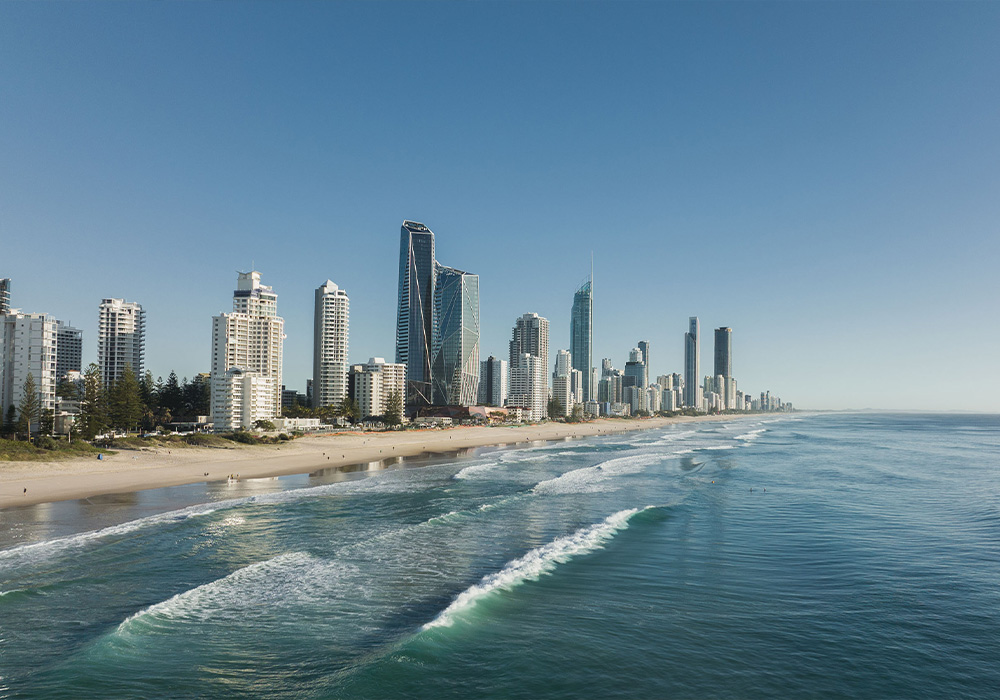
New apartment sales on the booming Gold Coast more than doubled over the September quarter. The surge came as a swath of cashed-up local and interstate buyers pounced on the larger, luxury residences that have become the post-COVID-19 staple of the coastal city market.
Quarterly data from research house Urbis shows 470 unit sales over July, August and September, a 135 per cent increase on the 200 sales recorded over the June quarter.
Off-the-plan apartment sales peaked in the final quarter of 2020 at almost 750, and were elevated throughout 2021 before rising interest rates reduced demand last year and the first half of this year.
Alongside the rebound in sales, an influx of buyers intend to pay for their multimillion-dollar homes in the sky with cash, thus not being affected by higher rates.
Analysis of recent off-the-plan apartment sales by Gold Coast project marketing firm Total Property Group found 80 per cent of buyers are paying entirely in cash. Almost all of them (96 per cent) are Australian.
Total Property specialises in luxury apartments with an average price of $2.6 million.
Managing director Adrian Parsons told The Australian Financial
Review buyers were paying cash for properties between $1 million and $10 million.
‘Unprecedented’ level
He said the “unprecedented” level of cash buyers was a reflection of the maturation of the Gold Coast apartment market, which had moved on from its past cycles of boom and bust.
Alongside a more stable market, there has been an evolution of the product offering from small, holiday units to the big half and full-floor residences catering to wealthy owner-occupiers.
“The small one and two-bedroom holiday apartments of the past never appealed to high-net-worth buyers, who stayed at the Sheraton or Versace [now The Imperial], but never felt there was a premium offering to invest in,” Mr Parsons said. “That’s all changed now.”
Another key change in the market identified by Total Property was the high proportion of Queenslanders – 57 per cent – who were buying new luxury apartments. That was up from 40 per cent 12 months ago.
‘Now a beachside metropolis’
Many of these buyers, Mr Parsons said, had done well out of property, and were now putting their wealth into a destination offering an enviable coastal lifestyle and good employment prospects.
“The Gold Coast is now a beachside metropolis,” Mr Parsons said. “When you look at the employment sectors, the medical sector is now bigger than tourism. It’s become a bona fide oceanside city with lifestyle benefits that are unmatched.”
Growing demand for larger, luxury apartments, which really accelerated during the pandemic, has brought in some big name property developers. They include veteranDavidDevine and interstate Rich Listers suchas Tim Gurner and SamArnaout.
However, high construction costs and labour shortages remain a challenge. Last year, Melbourne-based development giant Central Equity canned a $500 milion apartment project at Surfers Paradise,citing surging construction costs.
Others, such as Cronulla-based Sammut Group and Mr Arnaout’s Iris Capital, are forging ahead with construction of luxury beachfront towers.
The biggest-selling Gold Coast project
Over the September quarter, the biggest-selling Gold Coast project – according to Urbis – was Drew Group’s Lagoon project at Main Beach, which is being built by Hutchinson Builders and racked up 124 sales across two towers.
The first stage of Cienna, a multi-tower project in Varsity Lakes being undertaken by Ron Bakir’s Homecorp, secured 85 sales. Meanwhile, 26 Vista, a high-rise tower at Surfers Paradise being developed by Malaysian-listed MRCB Malaysia, sold 80 apartments over the quarter.
Nearly 1800 apartments remained up for sale at the end of September – 82 per cent of which are in Surfers Paradise, Main Beach and Broadbeach, according to Urbis.
Urbis director Paul Riga said a significant new trend was the conversion of a number of build-to-rent projects to build-to-sell as developers look to capture sales in a constrained supply environment.
“What the data tells us quite simply is that the demand for apartments has remained strong,” Mr Riga said.
“This is great for the property market, underpins property prices, but creates further problems with supply – meaning if new projects don’t get under way, the supply will continue to diminish.”
Back to the news